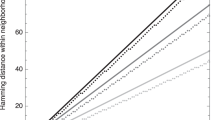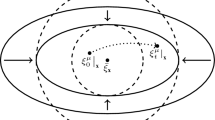Abstract
A theory for describing evolution as adaptive walks by a finite population with M walkers (M ≥ 1) on an anisotropic Mt. Fuji-type fitness landscape is presented, from a thermodynamical point of view. Introducing the ‘free fitness’ as the sum of a fitness term and an entropy term and ‘evolutionary force’ as the gradient of free fitness on a fitness coordinate, we demonstrate that the behavior of these theoretical walkers is almost consistent with the thermodynamical schemes. The major conclusions are as follows: (1) an adaptive walk (=evolution) is driven by an evolutionary force in the direction in which free fitness increases; (2) the expectation of the climbing rate obeys an equation analogous to the Einstein relation in Brownian motion; (3) the standard deviation of the climbing rate is a quantity analogous to the mean thermal energy of a particle, kT (×constant). In addition, on the interpretation that the walkers climb the landscape by absorbing ‘fitness information’ from the surroundings, we succeeded in quantifying the fitness information and formulating a macroscopic scheme from an informational point of view.
Similar content being viewed by others
References
Adami, C., C. Ofria and T. C. Collier (2000). Evolution of biological complexity. Proc. Natl. Acad. Sci. USA 97, 4463–4468.
Aita, T. and Y. Husimi (1998). Adaptive walks by the fittest among finite random mutants on a Mt. Fuji-type fitness landscape. J. Theor. Biol. 193, 383–405.
Aita, T. and Y. Husimi (2000). Adaptive walks by the fittest among finite random mutants on a Mt. Fuji-type fitness landscape II: Effect of small non-additivity. J. Math. Biol. 41, 207–231.
Aita, T. and Y. Husimi (2003). Thermodynamical Interpretation of an adaptive walk on a Mt. Fuji-type fitness landscape: Einstein relation-like formula holds in a stochastic evolution. J. Theor. Biol. 225, 215–228.
Dill, K. A. (1997). Additivity principles in biochemistry. J. Biol. Chem. 272, 701–704.
Dill, K. A. and H. S. Chan (1997). From Levinthal to pathways to funnels. Nat. Struct. Biol. 4, 10–19.
Eigen, M. (1985). Macromolecular evolution: dynamical ordering in sequence space. Ber. Bunsenges. Phys. Chem. 89, 658–667.
Eigen, M. (2000). Natural selection: a phase transition? Biophys. Chem. 85, 101–123.
Einstein, A. (1905). On the movement of small particles suspended in stationary liquids required by the molecular-kinetic theory of heat. Ann. Phys. 17, 549–560 (in German).
Iwasa, Y. (1988). Free fitness that always increases in evolution. J. Theor. Biol. 135, 265–281.
Kauffman, S. A. (1993). The Origin of Order, Oxford: Oxford University Press.
Kim, J. T., T. Martinetz and D. Polani (2003). Bioinformatic principles underlying the information content of transcription factor binding sites. J. Theor. Biol. 220, 529–544.
Manrubia, S. C., E. Lazaro, J. Perez-Mercader, C. Escarmis and E. Domingo (2003). Fitness distributions in exponentially growing asexual populations. Phys. Rev. Lett. 90, 188102.
Maynard-Smith, J. (1970). Natural selection and the concept of a protein space. Nature 225, 563–564.
Prügel-Bennett, A. (1997). Modelling evolving populations. J. Theor. Biol. 185, 81–95.
Rechenberg, I. (1984). The evolution strategy: a mathematical model of Darwinian evolution, in Synergetics: From Microscopic to Macroscopic Order, Vol. 22, E. Frehland (Ed.), Springer Series in Synergetics, pp. 122–132.
Voigt, C. A., S. Kauffman and Z. G. Wang (2000). Rational evolutionary design: the theory of in vitro protein evolution. Adv. Protein Chem. 55, 79–160.
Weinberger, E. D. (2002). A theory of pragmatic information and its application to the quasi-species model of biological evolution. Biosystems 66, 105–119.
Woodcock, G. and P. G. Higgs (1996). Population evolution on a multiplicative single-peak fitness landscape. J. Theor. Biol. 179, 61–73.
Yamauchi, A., T. Nakashima, N. Tokuriki, M. Hosokawa, H. Nogami, S. Arioka, I. Urabe and T. Yomo (2002). Evolvability of random polypeptides through functional selection within a small library. Protein Eng. 15, 619–626.
Author information
Authors and Affiliations
Corresponding author
Rights and permissions
About this article
Cite this article
Aita, T., Morinaga, S. & Husimi, Y. Thermodynamical interpretation of evolutionary dynamics on a fitness landscape in a evolution reactor, I. Bull. Math. Biol. 66, 1371–1403 (2004). https://doi.org/10.1016/j.bulm.2004.01.004
Received:
Accepted:
Issue Date:
DOI: https://doi.org/10.1016/j.bulm.2004.01.004




